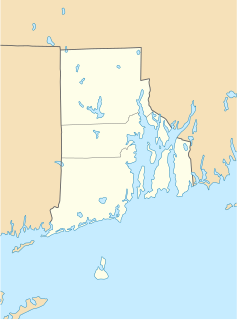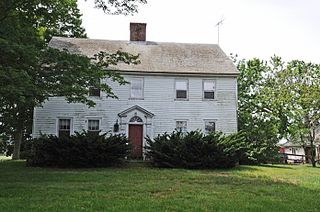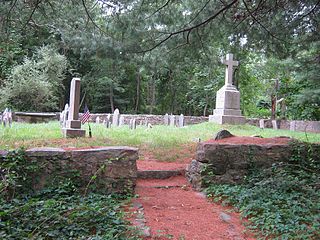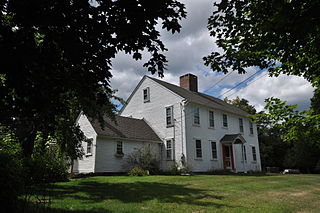
North Kingstown is a town in Washington County, Rhode Island, United States, and is part of the Providence metropolitan area. The population was 27,732 in the 2020 census. North Kingstown is home to the birthplace of American portraitist Gilbert Stuart, who was born in the village of Saunderstown. Within the town is Quonset Point, location of the former Naval Air Station Quonset Point, known for the invention of the Quonset hut, as well as the historic village of Wickford.

Saunderstown is a small village and historic district in the towns of Narragansett and North Kingstown in Washington County, Rhode Island, United States. Saunderstown has its own post office with the ZIP Code of 02874, which also includes a small part of South Kingstown. Its population is 6,245.

The Allen–Madison House is a historic house on Marine Road in North Kingstown, Rhode Island. It is located on the grounds of the former Davisville Naval Construction Battalion Center, set on an isolated plot apart from the main portion of the base.

The Peleg Champlin House is an historic house on Rodman Pond Lane in western New Shoreham, on Block Island, in Rhode Island. It is a 1+1⁄2-story wood-frame structure, five bays wide, with a side-gable roof and a large central chimney. An ell extends from the back (north) side of the house. The Federal style wooden house was built c. 1820 by Peleg Champlin, a farmer from one of the island's older families. The house is one of the best-preserved houses of the period on the island.

The Cottrell House is a historic house in South Kingstown, Rhode Island. The house is the centerpiece of a working farm complex which includes 73 acres (30 ha) of land, and is one of South Kingstown's last working farms. The house, built c. 1790, is a fairly typical Federal style structure, 2-1/2 stories tall, five bays wide, with a large central chimney. The main barn, located south of the house, is believed to be contemporary to the house, although it has undergone some alteration and extension in the 20th century.

The Crowfield Historic District is a small residential historic district in North Kingstown, Rhode Island. It encompasses a cluster of four early 20th-century summer houses, all connected via family or friendship connections to the writer Owen Wister. The occupy a large parcel of land sloping down to the shore of Narragansett Bay on the east side of Boston Neck Road, a short way north of the Jamestown Verrazzano Bridge. The area was named "Crowfield" by Elizabeth Middleton Cope, who built a Shingle-style mansion in 1906. Owen Wister, her uncle, built his house, Champ de Corbeau, in 1909-10 to a design by Grant Lafarge. The Jamieson House was also built in 1906, and was designed by the same architect, James P. Jamieson. The fourth house, Orchard House, was built in 1924. All are Shingle style houses. The compound is unusual for North Kingstown, where most summer estates were isolated individual properties.

The Davisville Historic District is a historic district on Davisville Road in Davisville, Rhode Island, a village in North Kingstown. It encompasses the site of an early 19th-century mill, and several associated buildings, including five houses dating to the 18th or 19th century and a cemetery. It is located on either side of Davisville Road, between the Hunt River and Olde Mill Lane.

The George Douglas House is an historic house at Tower Hill and Gilbert Stuart Roads in North Kingstown, Rhode Island. Its oldest section dated to the 1730s, it is one of a small number of surviving colonial-era stone ender houses in the state. This original block is three bays wide and two stories high, with a massive fieldstone chimney at its north end. Its exterior ornamentation is minimal, limited to pilasters on either side of the main entrance, and a triangular pediment above. A small kitchen ell was added to the north side, probably early in the 19th century, and a bedroom further extended this ell in the 1940s.

The Ezekial Gardner House was an historic house at 297 Pendar Road in North Kingstown, Rhode Island. It was a 1+1⁄2-story wood-frame house, with a gambrel roof. The oldest portion of the house dated to the early 18th century, and was the best-preserved of several period houses built by members of the locally prominent Gardner family. The house stood, along with an early 20th-century barn, at the end of a long tree-lined lane on the west side of Pendar Road.

The Kingston Hill Farm, also known as the Potter-Peckham Farm, is a historic farm in South Kingstown, Rhode Island. The 20-acre (8.1 ha) farm is centered on a building complex with a c. 1810 1-1/2 story wood frame farmhouse, which follows a typical plan of five bays with a central chimney. Behind the house are a seed barn and wagon shed, both dating to the early 20th century. A family cemetery with 18th-century graves is located near the southern boundary of the property. The farm was first established by William Potter in the 1730s; by the early 18th century it came into the hands of Elisha Reynolds Potter, who operated it as a tenant farm. Potter tore down the original farmhouse and built the now-surviving smaller house.

The Old Narragansett Cemetery is an historic cemetery on Shermantown Road in North Kingstown, Rhode Island. Variant names for the cemetery include Narragansett Cemetery, Platform Cemetery, and The Platform Cemetery. The cemetery occupies a 1.2 acres (0.49 ha) plot about 300 feet (91 m) south of Shermantown Road, roughly midway between its two junctions with Mourning Dove Drive. It was established early in the 18th century, and is one of North Kingstown's oldest and longest-used cemeteries. It has 110 marked graves, and was used from its establishment c. 1705 to the 1880s. The most prominent memorials are to James MacSparran and Samuel Fayerweather, two long-serving ministers at the Old Narragansett Church, which stood nearby when it was built in 1706.

The Palmer–Northrup House is an historic house at 7919 Post Road in North Kingstown, Rhode Island. It is a 2+1⁄2-story wood-frame structure, and is one of a small number of surviving stone ender houses in the state. Its architecture suggests it was built in the 17th century, either around the time of King Philip's War (1675–78) or possibly even earlier. The oldest portion of the house, including its massive fieldstone chimney, are relatively intact despite later additions around 1740 that significantly enlarged the house. The house stands across the street from Smith's Castle, a house of similar vintage which was built on the site of a trading post established by Roger Williams in 1637.

The Joseph Pierce Farm is an historic farm at 933 Gilbert Stuart Road in North Kingstown, Rhode Island. It consists of 18 acres (7.3 ha) of land, along with an 18th-century farmhouse and a number of 19th-century outbuildings. The oldest portion of the house, its southern ell, was originally built with a gable roof, but this was extended to the north in the late 18th or early 19th century, and given it present gambrel roof and Federal styling. Later additions in the 19th and 20th centuries gave the house its present cruciform appearance. Outbuildings dating to the 19th century include a barn with attached privy, a toolshed, and a henhouse. The complex is a well-preserved reminder of the area's rural heritage.

The Esbon Sanford House is an historic house at 88 Featherbed Lane in North Kingstown, Rhode Island. It is a 1+1⁄2-story wood-frame structure, five bays wide, with a central chimney and simple Federal-Greek Revival transitional styling. The main entry, centered on the front facade, is framed by small sidelight windows and pilasters, and is topped by an entablature. The most unusual feature of the house relates to its chimney: despite its central location, the interior of the house is organized in a central hall plan, with the flues of the flanking chambers rising at an angle and joining in the attic space to form the single chimney seen outside. The house was probably built in 1832 by Esbon Sanford, who established a textile mill nearby that same year.

Six Principle Baptist Church is a historic church in North Kingstown, Rhode Island. As of 2009 it was one of the last surviving historical congregations of the Six Principle Baptist denomination and one of the oldest churches in the United States.

The Joseph Slocum House is an historic house on Slocum Road in North Kingstown, Rhode Island. It is a 1+1⁄2-story wood-frame house, five bays wide, with a large central chimney. It faces south on the east side of Slocum Road. The house has been dated to the mid-18th century based on architectural evidence; its first documented owner was Joseph Slocum, in the early 19th century. The house is a rare surviving 18th-century farmhouse, a type once numerous in the town.

The Spink Farm is a historic farm at 1325 Shermantown Road in North Kingstown, Rhode Island. The only surviving element of the farmstead on this 55-acre (22 ha) farm is the main house, a 2+1⁄2-story five-bay wood-frame structure built in 1798 by Isaac Spink. The house exhibits modest Federal styling, its doorway flanked by small sidelight windows and simple pilasters, and topped by a shallow hood. The interior follows a typical center-chimney plan, with its original Federal period fireplace mantels intact. The house has been extended to the rear by a kitchen ell and porch, both added in the 20th century. The house is one of a small number of 18th-century farmsteads left in the town.

The William Waterman House is a historic house in Coventry, Rhode Island. It is located on the west side of Rhode Island Route 102, a short way north of its junction with Bowen Hill Road. The 2+1⁄2-story wood-frame house was built, probably before 1793, by William Waterman, a descendant of one of Coventry's earliest European settlers. It is five bays wide, with a large central chimney. Its entry is the most elaborate part of the main facade, flanked by paired pilasters and sheltered by a barrel-vaulted portico with triangular pediment.

The David S. Baker Estate, also known as Cedar Spring Farm, consists of a pair of related properties at 51 and 67 Prospect Avenue in the Wickford village of North Kingstown, Rhode Island. David Sherman Baker, Jr., a prominent local lawyer and contender for statewide offices built the house around 1882 with his wife. Members of the Baker family built the Italianate, the older of the two houses, 51 Prospect Avenue, which is a 1+1⁄2 story mansard-roofed that is modest in size but features an elaborate wrap around veranda decorated in fairly elaborated Italianate and Second Empire styling. The house at 67 Prospect is much larger 2+1⁄2 story construction, with a 3+1⁄2 story tower and front veranda, again in eclectic Second Empire style. It is one of the largest houses in Wickford, and was referred to by the family as the "Big House". It is unclear whether Baker built the Big House to accommodate his growing family, or as a venue for functions that were part of his political and social activities.

The Samuel Clarke House is a residential structure dating to c. 1691. It's one of the earliest surviving houses in the State of Rhode Island. It is the central building of the “Samuel Clarke Farm”, now a 40-acre parcel in Kenyon, Rhode Island, within the Town of Richmond. The farm is bordered to the west by the Beaver River. This property was originally part of a larger parcel that was sold in 1662 by the Niantic Sachem Wanumachon. This historic land transaction is known as the Stanton Purchase.






















